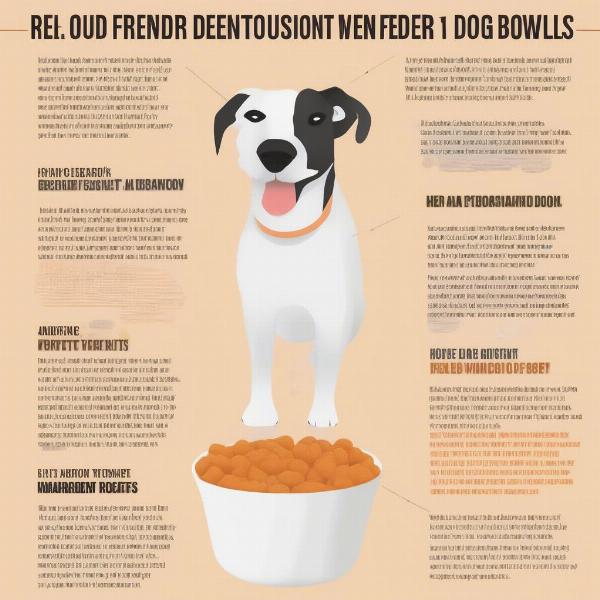Slow feeder dog bowls have become increasingly popular among pet owners looking to improve their furry friends’ mealtime experience. These specially designed bowls help prevent dogs from gulping down their food too quickly, which can lead to a variety of health issues. In this comprehensive guide, we’ll explore the benefits of using slow feeder dog bowls, different types available, and how to choose the right one for your canine companion.
Why Use a Slow Feeder Dog Bowl?
Many dogs, especially those with a competitive or anxious nature, tend to inhale their food as fast as possible. This rapid eating can lead to several problems, including:
- Bloat (Gastric Dilatation-Volvulus): This life-threatening condition occurs when the stomach fills with gas and twists, cutting off blood supply. Large breed dogs are particularly susceptible, and rapid eating is a known risk factor.
- Vomiting: Gulping down food without properly chewing can lead to regurgitation soon after eating.
- Choking: Pieces of kibble can become lodged in the throat if swallowed whole.
- Obesity: While not directly causing obesity, rapid eating can make it harder for dogs to recognize when they’re full, potentially leading to overeating.
 Benefits of using slow feeders for dogs
Benefits of using slow feeders for dogs
A slow feeder bowl introduces obstacles and ridges that force your dog to slow down and work for their food. This extends mealtime, promotes proper chewing, and helps prevent these potential health risks.
Types of Slow Feeder Dog Bowls
There are several types of slow feeder bowls available, each with its unique design and features:
Maze Bowls
These bowls feature a raised pattern that creates a maze-like structure. Dogs have to navigate their tongue around the obstacles to get to their food. Maze bowls are generally suitable for most breeds and offer varying levels of difficulty.
Raised Center Cone Bowls
These bowls have a single, large cone in the center, forcing dogs to eat around it. This type is often effective for dogs who are particularly fast eaters.
Puzzle Feeders
Puzzle feeders take the slow feeding concept a step further by requiring dogs to solve puzzles or manipulate toys to access their food. These are great for mental stimulation and can help keep dogs entertained during mealtimes.
Slow Feeder Mats
These mats are a good alternative to bowls, especially for dogs who like to lick their food. The textured surface of the mat slows down eating and can be easily cleaned.
Choosing the Right Slow Feeder Bowl
When selecting a slow feeder bowl for your dog, consider the following factors:
- Breed and Size: Choose a bowl that is appropriately sized for your dog’s breed and mouth. Larger dogs need bigger bowls with wider spacing between obstacles.
- Eating Habits: If your dog is an extremely fast eater, you might need a bowl with a more complex design.
- Material: Look for durable, non-toxic materials like stainless steel or food-grade plastic.
- Ease of Cleaning: A bowl that is easy to clean will prevent the buildup of bacteria.
What if My Dog Doesn’t Like the Slow Feeder?
Some dogs may initially be hesitant to use a slow feeder bowl. Here are some tips to encourage acceptance:
- Introduce it gradually: Start by adding a small amount of food to the slow feeder while still offering some food in their regular bowl.
- Make it fun: Use high-value treats or spread peanut butter (xylitol-free) on the slow feeder to create positive associations.
- Be patient: It may take some time for your dog to adjust to the new bowl.
Conclusion
Slow feeder dog bowls are a valuable tool for promoting healthy eating habits and preventing potential health problems. By slowing down mealtime, these bowls can improve digestion, reduce the risk of bloat, and even help with weight management. By considering your dog’s individual needs and choosing the right type of slow feeder, you can help your furry friend enjoy a safer and more satisfying mealtime experience. Remember to check out our other articles on slow feeder dogs and slow dog food feeder for more tips and recommendations.
FAQ
- Do all dogs need a slow feeder bowl? While not strictly necessary for every dog, slow feeders are particularly beneficial for fast eaters and those prone to bloat.
- Can puppies use slow feeders? Yes, slow feeders can be used for puppies, but make sure to choose one that is appropriately sized for their small mouths.
- How do I clean a slow feeder bowl? Most slow feeders are dishwasher safe. Hand washing with warm soapy water is also effective.
- What if my dog still eats too fast even with a slow feeder? You might need to try a different type of slow feeder with a more challenging design.
- Are slow feeders suitable for all types of dog food? Yes, slow feeders can be used with both dry kibble and wet food.
- Can a slow feeder help my dog lose weight? While not a weight loss solution on its own, a slow feeder can contribute to weight management by helping dogs feel fuller for longer.
- My dog keeps tipping over their slow feeder. What can I do? Look for a slow feeder with a non-slip base or consider a slow feeder mat.
You Might Also Like
dog bowl slow feeder
large dog bowl slow feeder
dog food slow feeder
ILM Dog is your trusted international resource for expert dog care advice. We cover a wide range of topics, from breed selection and health care to training, nutrition, and grooming. Our goal is to provide practical and reliable information to help dog owners worldwide ensure the well-being of their beloved pets. Learn more about our services and products for all your dog-related needs by contacting us at [email protected] or +44 20-3965-8624. Visit ILM Dog today for more helpful resources.